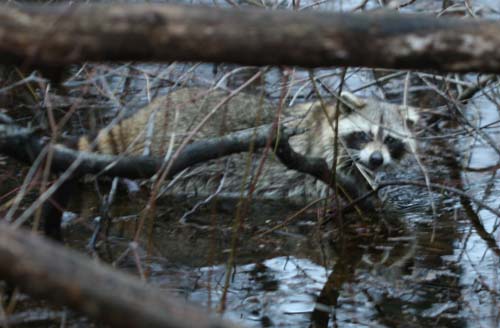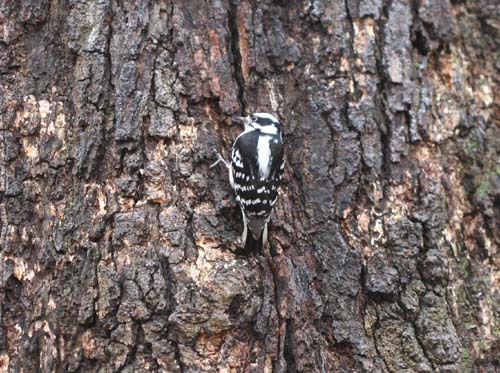I got an early start yesterday morning in the hopes of finding migrant warblers in Forest Park. The rain and strong south winds we had the night previous had given way to strong northwest winds yesterday morning and sunrise was obscured by lots of clouds. In other words, it was a pretty gray start to the day. The three-block walk to Forest Park netted me the expected three species in such an urban environment: House Sparrows, European Starlings, and Rock Pigeons. Once I reached the park American Robins were singing from the treetops and scuttling through the undergrowth and Dark-eyed Juncos were trilling from the bushes.
At the waterhole, sitting on a nice flat rock because my usual log-seat was quite wet, I quickly added the two mammals I normally see in Forest Park, Eastern Gray Squirrels and Eastern Chipmunks, in addition to the usual Northern Cardinals, White-throated and Song Sparrows, the Eastern Towhee that wintered, and Hairy, Downy, and Red-bellied Woodpeckers. It was the third mammal that surprised me, a big ol’ Raccoon walking through the edge of the waterhole!
After watching the Raccoon amble off into the bushes I started to pay attention to the birds again, adding singing Carolina Wrens to my day list. I made my way to the feeders that some nice person keeps stocked and came across the usual Mourning Doves and Dark-eyed Juncos hanging out beneath the thistle-sock feeder, cleaning up the mess that the feeding American Goldfinches were making. A Hermit Thrush caught my attention for awhile, singing very softly, as if it were auditioning for the virtuoso performances it will make when it arrives at its breeding grounds further north. Listening to the soft song of a Hermit Thrush, barely audible over the sounds of traffic filtering through the trees, made getting up on such a gray and windy morning worthwhile. Little did I know I would soon have another encounter that made my early morning a good one.
As I walked along the equine trail (yes, believe it or not there is horseback riding in Forest Park) I spotted a bunch of birds foraging in the undergrowth in a large depression in the ground. At first all I spotted were White-throated Sparrows but one of them was too small and had an olive back. When I finally got a clear look at the bird, which was walking through the leaf litter with an odd, familiar gait, the black-bordered orange head stripe jumped out at me…holy cow, an Ovenbird! I had expected a Pine or Palm Warbler to be my first warbler of the spring (after, of course, the wintering Butterbutts) but I certainly didn’t mind seeing an Ovenbird, especially when it gave me prolonged, though distant, looks at it foraging at the edge of the White-throated Sparrow flock. I couldn’t manage to get a picture so if you really want to see one check out this post Charlie did awhile back. And, by the way, according to an email I received from another Forest Park birder, an Ovenbird had been seen off and on through December and the beginning of January, so it seems likely that the warbler wintered in the park [Update: Oops! I misread the email: the Ovenbird that was seen over the winter was last winter, not this one. But, nonetheless, it is way too early for one of these birds to be migrating so I still think it wintered].
That was pretty much it for the morning, though I did manage to add Eastern Phoebe, Yellow-bellied Sapsucker and some other common species before I headed home to write this post and get ready for work.
Downy Woodpecker














So yet again, you have utterly failed in finding a Black-backed Woodpecker?
Location, man, it’s all about location!
At least I found a white-and-black-backed woodpecker…is that close enough?